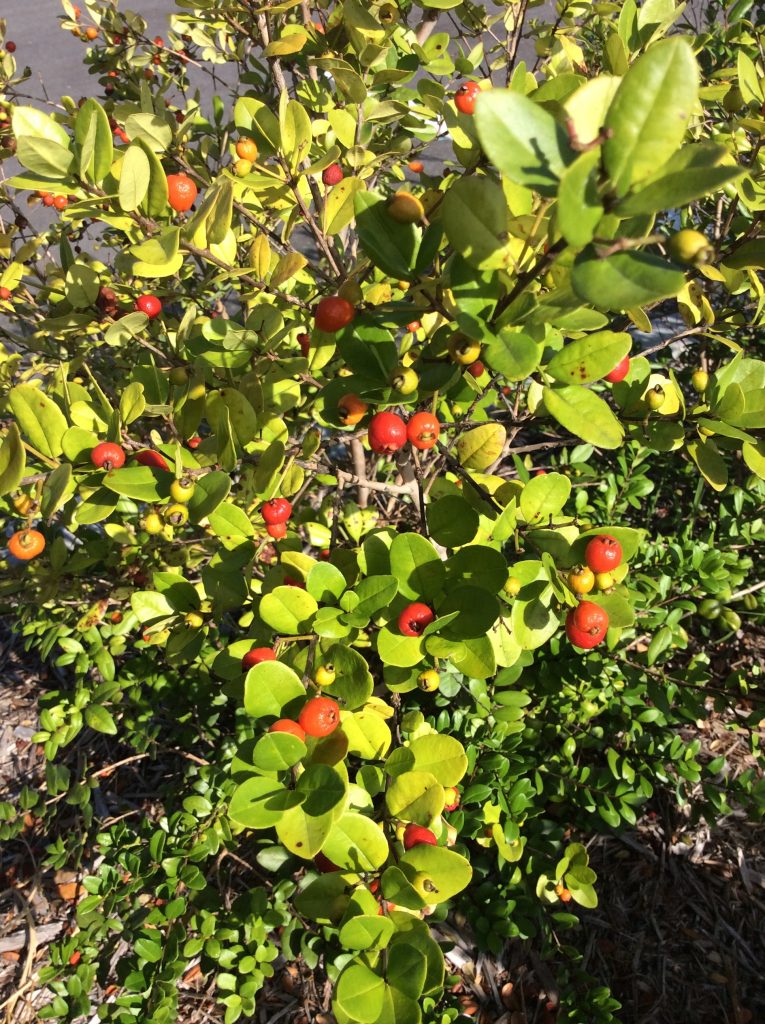
The orange and red fruit of the Simpson Stopper. Photos by Green Deane
Myrcianthes fragrans: Nakedwood Twinberry
I took me about a year to know the Simpson Stopper.
While most people think of Florida as flat there’s actually is a ridge down the middle of the state reportedly from dune fields created in the Pliocene Age, 2.5 to 5.3 million years ago. If you ever drive Interstate 4 from Daytona Beach to Tampa at Lakeland the highway drops over 100 feet down an ancient ocean escarpment, dramatically marking an end to a portion of the ridge. It’s flat from there southwest to Tampa, once ocean bottom.
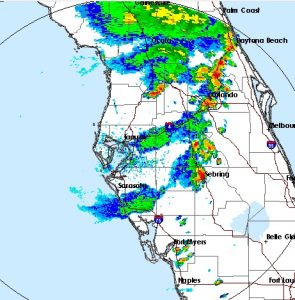
There more between Daytona Beach and Tampa than Interstate 4. It’s a limestone ridge that crosses and also drops down from the middle towards Sebring. The geographical difference engenders thunder storms.
Several species grow across the flat southern end of Florida and up both sides but not in the higher middle, which tends to be a few degrees cooler in the winter. That is the case with the Simpson Stopper aka Myrcianthes fragrans (mer-see-ANTH-eez FRAY-granz) which is hardy down to 25° F, perhaps into the teens if well-established. Inland it grows to just north of Lake Okeechobee, then reaches its botanical arms north along the west coast to Tampa and St. Augustine on the east coast but not naturally up the middle of the state.
I first saw it in at the southern end of the state in Dreher Park, West Palm Beach. It was a small tree. The next time was near the manatee viewing area at Haul Over Canal near the space center, some 200 miles north, a small tree that from a distance could be mistaken for a holly. Both Stoppers were intentionally planted but in south Florida and the islands also grows wild.
I did not find the artificial mother load of Simpson Stoppers but one of my foraging students did. He asked me to visit a local Wholefood’s store in Orlando to look at the landscaping around the shopping center. He said there was a plant there he couldn’t identify. I found a quarter-mile long hedge of Simpson Stopper, in fruit.
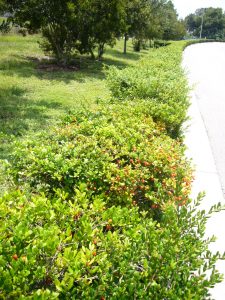
It’s becoming a popular hedge plant.
M. fragrans is in the eucalyptus family. If you crush a leaf it does not smell of eucalyptus but rather citrusy, some think nutmeg, some think a piney citrus aroma. The blossoms are pleasantly fragrant, which helps you identify it from an unpleasant smelling relative, the Spanish Stopper. The sweet, mealy pulp of the red, ripe fruit is edible, but not the seeds as far as I know. Besides, they taste bad. That I do know. The genus is closely related to Guavas as well as Syzigums and Eugenias, In the past many species were moved in and out of these genera and at one time M. fragrans was Eugenia simpsonii. In fact, the particular plant has had some 27 genus or species name changes. E. simpsonii honored Charles Torrey Simpson, a naturalist and author in Miami in the early 1900’s.
Not only are there several “Stoppers” as they are called, but the aforementioned genera also look similar, whether in Florida or Australia. They are generally shrubs to small trees, with leaves about one to two inches long and a half inch to an inch wide. Some have rounded leaves, some have pointed leaves, some are notched. The fruit varies from a black berry to a tiny deep red berry that looks like a pumpkin (the Surinam Cherry.) Some have one or two seeds, others like the Strawberry Guava have many seeds. The fruit tastes like mild orange peeling. They can be small bushy to tall and leggy. In landscaping they are an accent species as well as good hedge material.
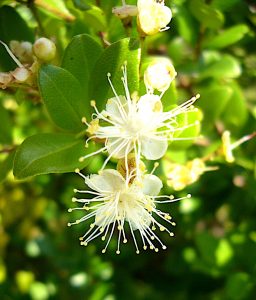
The blossoms are frilly.
There are several identifying characteristics of the Simpson Stopper. Let’s start with the little ones. The orange to red fruit is often in pairs and has a little four-sided round pucker at the end (kind of like a little folded-in blueberry crown made of four triangles.) The closely related Syzigums have a wrinkled cross at the end of the fruit. The leaf of the M. fragrans is also covered with dots. Under a #10 loop the upper surface of the leaf looks like it is covered with tiny drops of water (the dots.) The underside of the leaf is often decked out in what appears to be very tiny green dots, sometimes blackish dots. If you hold the leaf to the light and use a loop you will see gold dots. The leaves can also curl under at the edge. The fruit has one or two bean-shaped seeds, two being more common, often stuck together. They are one of the favored foods of Cardinals and the Mocking Bird, which is Florida’s state bird. The sweet blossoms attract butterflies.
Also called “nakedwood” because of its smooth bark, it is often planted for its leggy multi-trunk wild growth pattern. Botanically Myrcianthes fragrans means “many thorns fragrant.” In this case the “many thorns” refers to the many stamens of the flower, which is also quite fragrant.
Other “stoppers” you might come across include the rare Eugenia confusa (Redberry Stopper), the Eugenia rhomea (Redberry Stopper) whose new growth is pale red while old growth has tiny black dots on the underside of the leaves; Eugenia foetida (Redberry Stopper) whose leaves and flowers smell foul; and the White Stopper, Eugenia axillaris so called because it has light-colored bark, edible mealy fruit.
Green Deane’s “Itemized” Plant Profile
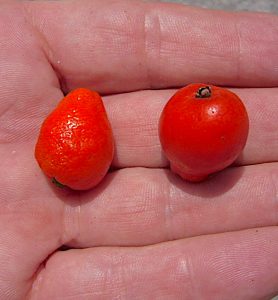
The berries can reach good size. Don’t eat the seed.
IDENTIFICATION: A tree to 55 feet, and 14 inches through, inner reddish brown bark, flaking, growth similar to a crape myrtle, twigs slender, brown, finely hair. Leaves to two inches long, an inch wide, opposite, finely hairy petioles, blunt or rounded at the end, sometimes notched, sometimes pointed, minute gland dots, upper surface shiny dark green, under light dull green. Flowers in clusters, many spreading white stamens, see right.
TIME OF YEAR: Can fruit and flower year round, but favors August and September.
ENVIRONMENT: Full sun to partial shade, likes to be irrigated, hardy to 25F, found often growing over limestone, shell or marl.
METHOD OF PREPARATION: Pulp of ripe fruit is edible out of hand. The texture is soft and mealy. Fruit and bark are rumored to treat diarrhea when made into a tea but I’ve found no modern reference to support that.

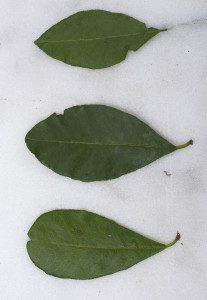

sir need to know what to feed for faster thicker growth ……acid or not thank you
Ours thrive in neutral to alkaline sandy soils (pH 7-7.2)….even in the areas where there are old shells mixed in from former shell driveways, pathways, and the drip line under the eaves.
I’ve seen them growing in old shell mounds on former Native American coastal settlements in Florida as well…..so I assume them to be rather alkaline tolerant.
They’re highly adaptable here in Zone 9A Homosassa, Florida, and in our yard, bloom and fruit in even the darkest shade. Our north-facing Myrcianthes fragrans, now approaching 12-15 feet tall, grow in the nearly total shade of our two story house; those on the east side of our house have only morning sun, and those on the west side, along a western fence line, likewise have afternoon shade….so I assume the species to be either shade-tolerant, or having a preference for the semi-shade of forest edges or even moderate mixed-deciduous forest canopy.
New seedlings in our garden (from the abundant fruits that drop (or are “pooped” by local birds/wildlife) sprout in everything from sand to caliche, to clay-sand, to carbon-rich mulch piles.
The little seedlings can take 3-5 years or more to get established, but after that, they really take off; so….patience, I bet, is all you need for your Simpson Stoppers to thrive 🙂 and become your own front or back yard fragrant evergreen self-seeding urban “forest.” Ours serve as both windbreak and privacy hedge, having an attractive natural form that rarely needs pruning, is generally slow growing, and requires very little maintenance.
One thing to note, though…get them out of pots as soon as possible, as those that become root-bound are uber-slow growing; possibly dwarfed. The non-aggressive roots of Myrcianthes fragrans definitely seem to have a preference for “in ground” conditions rather than pot culture. I think they may be naturally adapted for low nutrient situations where their main tap root proceeded downward swiftly when rain and other conditions were favorable, and their finer, more brittle branching roots had to search for limited nutrient resources, but ???? who knows…mine just seem to do better when I limit their “in pot time” to no greater than one year.
We started with one one-gallon plant from a local native plant society meeting, and from the fruits of that one plant, a veritable “front yard forest” has generously sprung up and provided us with generations of annual seedlings that we have moved to wherever “else” in the yard we thought suitable for this lovely fragrant, flowering, fruiting, well-behaved shrub / understory tree. The numerous birds and wildlife that have now “found us” kindly maintain the “forest” so that few new seedlings crowd the existing plants; the fruit seeds, via wildlife poop distribution, likely now “dispersed” in other yards in the neighborhood where they may find suitable soil conditions, and a gardener that doesn’t mind the new “volunteer” to the hedgerow, fence line, or under the power line easement (where so many birds seem to perch…and poop). That said, at least in our neighborhood, we see no evidence of Myrcianthes becoming a nuisance or invasive native.
Our oldest Myrcianthes fragrans, now about twenty years old, top out at about 12 feet tall, and will never threaten nearby powerlines in the front and side yards, or shade solar panels in our south-facing back yard :). Their roots have not strayed past their own drip line, and don’t seem to affect the native understory plants that have volunteered beneath them (ferns, violets, asters, Itea virginica, wild coffee, coral bean, etc.).
This time of year, when the trees are loaded with ripe fruit, the big fat raccoons that relish the “all you can eat” buffet break off the tallest branches (as they stuff their heavy, gluttonous selves), so annual “maintenance” involves either cleanly pruning off the roughly broken hanging branches from last evening’s wildlife fruit orgy, or preempting the damage by cleanly pruning off the terminal fruiting branches as soon as one sees them starting to bend from the weight of the ripe fruit load, then placing the fruit-laden cut branches in a safe, suitable location where local wildlife can feast without having to climb and damage major limbs that one may consider essential for attractive natural shape, shade, etc. in one’s landscape.
Congratulations on the lovely new native plant you’ve invited to your landscape. I’m sure it will reward delight you (and the local wildlife) with fragrant leaves, flowers, fruit, and “progeny” for years to come!
Remarkably thorough and thoughtful account for which I am most grateful, here in Baton Rouge, LA.
I was just wondering what color does fruit need to be when fully ripe ? Orange or black ? It is July in FL while I’m writing this and they are orange in color.
This specied they are red, or orange red. If you are in central to south Florida they should be ripe around now.
My Simpson Stopper has been growing beautifully here in Ocala (Central Florida). I’d never tried the berries, though, because I hadn’t been able to identify the shrub as edible until recently. It is a very attractive and prolific plant, the fallen fruit creating baby Stoppers all around the mother tree. It fits in well with my edible landscape.
do they have thorns and how do they taste? im unsure of what im pretty sure is a simpson stopper shrub and it would be wonderful to know
No thorns that I recall… ripe fruit kind of taste like sweet orange rind.
Where can I buy a Simson Stopper?
Most native nurseries carry them.
“Stopper” for the anti-diarrheal repute, or hedge planting, or…?
Do you know if these plants and/or berries are toxic to livestock?
What is the best way to trim a small Simpson Stopper into a tree?
What butterfly species use Simpson Stopper as a host plant?
We hv Simpson Stoppers in my adult community landscaping. I knew to taste it as it beckoned me. TY for telling us more. Didn’t know before. I hv eaten the seeds & tho yucky I haven’t gotten sick or died. Thinking of picking a bunch & blend in a smoothie or even freeze